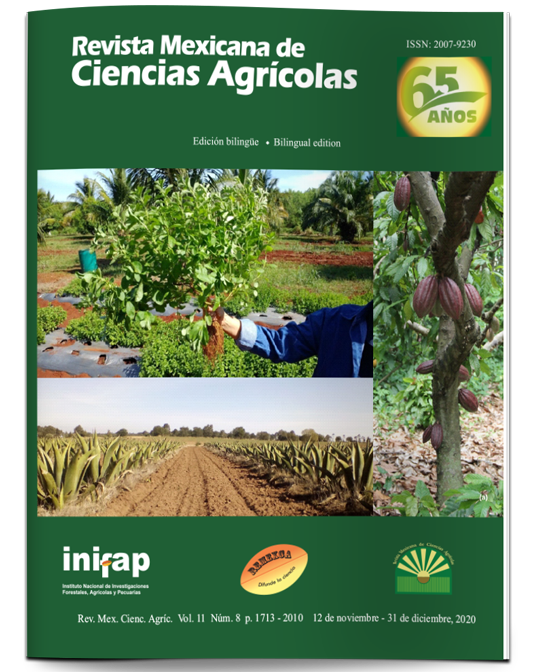Physiological races of Puccinia triticina E. identified in the North of Sinaloa and germplasm resistance
DOI:
https://doi.org/10.29312/remexca.v11i8.2574Keywords:
genotypes, resistance, virulenceAbstract
Leaf rust caused by Puccinia triticina E. is the most important disease in the North and Northwest of Mexico. In the North of Sinaloa, it is widely distributed in the wheat production areas of Valle del Fuerte and Valle del Carrizo; however, it is unknown which races are influencing that region. The objective was to identify the physiological races of leaf rust, which occur in the main producing areas of Northern Sinaloa, and to identify germplasm with resistance. During the autumn-winter 2018-2019 crop cycle, 50 samples of leaf rust were collected from experimental and commercial lots, these samples were transferred to Lanarec. With the monopostular technique, the identification of races was carried out. Subsequently, with the most frequent races, 35 bread wheat genotypes were evaluated under greenhouse conditions and for their resistance in seedlings and adult plants. Seven physiological races of leaf rust were identified (CBJ/QQ, MBT/SP, MCT/SP, MGJ/SP, MBJ/SP, MBJ/QQ, MFJ/SP), of which CBJ/QQ was identified with higher frequency (29%). Of the 35 genotypes evaluated with the CBJ/QQ and MCT/SP races, it was determined that
CONATRIGO F2015 and the lines CHEWINK #1/MUTUS//MUTUS*2/HARIL#1 and
MUTUS*2//ND643/2*WBLL1/3/BORL14 were resistant in seedling and adult plant to both races, which indicates that it possesses at least one gene for effective resistance to leaf rust. Genetic resistance is one of the most viable sustainable management alternatives for the control of wheat rusts in Mexico.
Downloads
Published
How to Cite
Issue
Section
License
Copyright (c) 2020 Revista Mexicana de Ciencias Agrícolas

This work is licensed under a Creative Commons Attribution-NonCommercial 4.0 International License.
The authors who publish in Revista Mexicana de Ciencias Agrícolas accept the following conditions:
In accordance with copyright laws, Revista Mexicana de Ciencias Agrícolas recognizes and respects the authors’ moral right and ownership of property rights which will be transferred to the journal for dissemination in open access. Invariably, all the authors have to sign a letter of transfer of property rights and of originality of the article to Instituto Nacional de Investigaciones Forestales, Agrícolas y Pecuarias (INIFAP) [National Institute of Forestry, Agricultural and Livestock Research]. The author(s) must pay a fee for the reception of articles before proceeding to editorial review.
All the texts published by Revista Mexicana de Ciencias Agrícolas —with no exception— are distributed under a Creative Commons License Attribution-NonCommercial 4.0 International (CC BY-NC 4.0), which allows third parties to use the publication as long as the work’s authorship and its first publication in this journal are mentioned.
The author(s) can enter into independent and additional contractual agreements for the nonexclusive distribution of the version of the article published in Revista Mexicana de Ciencias Agrícolas (for example include it into an institutional repository or publish it in a book) as long as it is clearly and explicitly indicated that the work was published for the first time in Revista Mexicana de Ciencias Agrícolas.
For all the above, the authors shall send the Letter-transfer of Property Rights for the first publication duly filled in and signed by the author(s). This form must be sent as a PDF file to: revista_atm@yahoo.com.mx; cienciasagricola@inifap.gob.mx; remexca2017@gmail.
This work is licensed under a Creative Commons Attribution-Noncommercial 4.0 International license.



